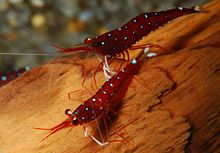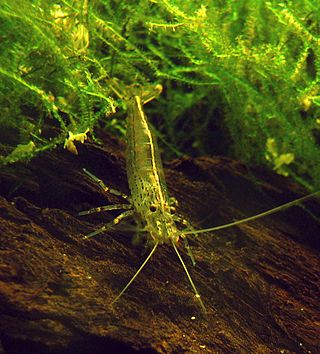
Atyidae is a family of shrimp, present in all tropical and most temperate waters of the world. Adults of this family are almost always confined to fresh water. This is the only family in the superfamily Atyoidea.
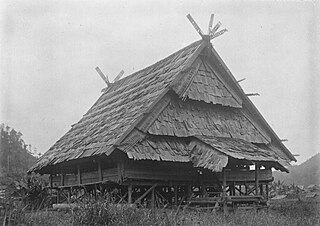
Lake Poso is a lake in Central Sulawesi, Indonesia, and the third-deepest lake in Indonesia.

Lake Towuti is a lake in East Luwu Regency, South Sulawesi province, Indonesia. Surrounded by mountains, it is the largest lake of the island of Sulawesi and one of the five lakes of the Malili Lake system. The Larona River flows from the lake to the Boni Bay. The town Laronda is located on its shore.
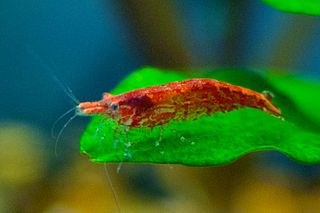
Neocaridina davidi is a freshwater shrimp originating from eastern China and northern Taiwan and introduced in the rest of Taiwan, Japan, and Hawaii, which is commonly kept in aquaria. The natural coloration of the shrimp is green-brown, though a wide variety of color morphs exist, including red, yellow, orange, green, blue, violet and black shrimp. Full-grown shrimp reach about 4 centimetres (1.6 in) long. N. davidi shrimp are omnivores that may live 1–2 years. These shrimps have previously been classified as Neocaridina heteropoda and Neocaridina denticulata sinensis, however are now known as Neocaridina davidi which is based on the oldest known published description of the species.

Caridina gracilirostris is a species of brackishwater shrimp belong to genus Caridina in the family Atyidae. It has a wide native range extending from Japan and Fiji through Indonesia to Madagascar. It is an algae-eating species that lives in mangroves and marshes. Its common names include red front shrimp, red rhinoceros shrimp, red nosed phantom shrimp, and needlenose caridina, red nosed shrimp.

Macrobrachium is a genus of freshwater prawns or shrimps characterised by the extreme enlargement of the second pair of pereiopods, at least in the male.
Dennerle is a German company producing aquarium and pond supplies. It was founded in 1966 as a pet store by Ludwig Dennerle in Pirmasens.

Caridina spongicola is a small species of freshwater shrimp from Sulawesi (Indonesia) that reaches 0.64 to 1.27 cm in length. In the wild it strictly lives on an undescribed species of freshwater sponge, making it one of only two known commensal species of freshwater shrimp. It is popularly known as the harlequin shrimp, and also sometimes Celebes beauty shrimp or sponge shrimp in the aquarium trade. It is often confused with Caridina woltereckae, a larger and more contrastingly colored species found in the same region as C. spongicola.

Caridina woltereckae, or Sulawesi harlequin shrimp as it is commonly known in the aquarium hobby, is a freshwater shrimp from Sulawesi, Indonesia. It is endemic to Lake Towuti. It resembles the smaller and less contrastingly coloured Caridina spongicola, which is endemic to the same lake.

Caridina striata is a freshwater shrimp from Sulawesi. It is endemic to Lake Poso and Lake Towuti. Common names in the aquarium hobby are red line shrimp and red stripe shrimp. It is commonly found on rocky substrates.
Caridina ensifera is a freshwater shrimp from Sulawesi. It is one of the 11 species of Caridina endemic to Lake Poso. It lives on a variety of substrates, including wood, rocks, sand and macrophytes, but is also found in pelagic swarms. It is suspected to only live in shallow water.

Caridina caerulea is a freshwater shrimp from Sulawesi. It is one of 11 species in the genus Caridina that is endemic to Lake Poso. It lives on a variety of substrates, including wood, rocks, sand and macrophytes. It is suspected only to live in shallow water.

Caridina loehae is a freshwater shrimp from Sulawesi. It is known as mini blue bee and orange delight shrimp in the aquarium trade. It is endemic to the Malili lake system. It lives on rocky substrates at a maximal depth of 5 metres.
Caridina lanceolata is a freshwater shrimp from Sulawesi. It is widespread in the Malili lake system, including all three lakes. It can be found in pelagic swarms, as well as on a variety of substrates.
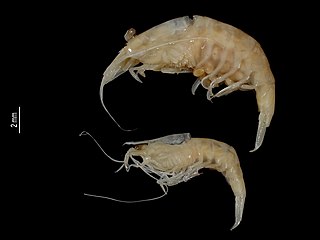
Caridina linduensis is a species of freshwater shrimp in the family Atyidae, endemic to Lake Lindu and its effluent stream in Sulawesi. It was known only from the type series, collected in 1904, and was recorded again in 2011 in a survey around Lake Lindu and is found in shallow littoral habitats of leaf litter, macrophytes, and dead wood. In the effluent stream it is found on soft substrates and slow flowing water, and is less common in the lake itself. The type locality of Lake Lindu was designated as a Recreation Park in 1978, and is part of the larger Lore Lindu National Park and UNESCO Biosphere Reserve. It is listed under IUCN criterion B1ab(iii,v) as Critically Endangered due to threats from introduced species of fish, land conversion to agriculture, logging, and shore disturbance caused by the grazing of water buffalo. Surveys are required to find the full distribution of C. linduensis, primarily its habitat in the effluent stream. C. linduensis is also sympatric with the recently described species Caridina dali and Caridina kaili.

Caridina typus, also known as the Australian Amano Shrimp, is a species of amphidromous atyid shrimp. It was first described by H. Milne-Edwards in 1837. It has a broad distribution in tropical freshwater habitats in the Indo-West Pacific region, with its western range extending to eastern Africa and its eastern range extending to Polynesia. It is commonly found in rivers and streams in coastal areas or on islands. C. typus is known to play a role in sediment distribution and shredding leaf litter, manipulating the environment using their pereiopods and setaceous chelae. The species is also an important component of the food web, both as scavengers and as prey items, and is considered a keystone species for the stream ecosystems it inhabits. According to Choy and Marshall, the species can be characterized by a "short, dorsally unarmed rostrum, the presence of epipods on the first four pairs of pereiopods, and the presence of an appendix interna on the endopod of the first pleopod of both sexes." It can be kept in captivity by aquarists as pets.

Caridina glaubrechti is species of lacustrine fresh water shrimp endemic to western part of Lake Towuti on the Indonesian island of Sulawesi. It is named in honor of German Zoologist Matthias Glaubrecht.
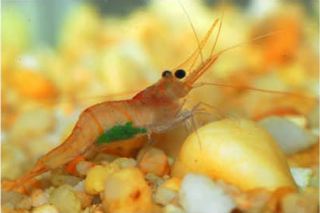
Caridina profundicola is species of fresh water shrimp endemic to Lake Towuti on the Indonesian island of Sulawesi.

Caridina holthuisi is a species of freshwater shrimp in the family Atyidae, endemic to the Malili lake system in Sulawesi, Indonesia. It can be found in Lake Towuti, Lake Matano, and Lake Mahalona, as well as the Petea river. It is named in honour of Dutch carcinologist, Lipke Holthuis.

Caridina sarasinorum is a species of freshwater atyid shrimp. It is one of eight Caridina species endemic to Lake Poso.


